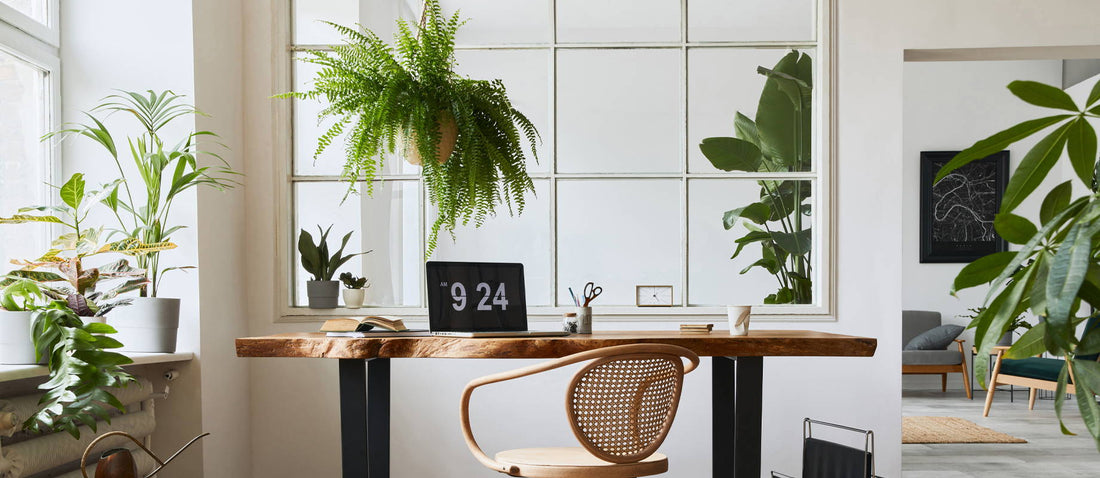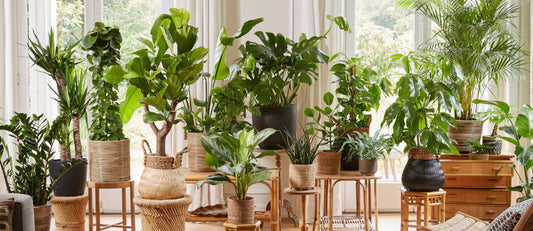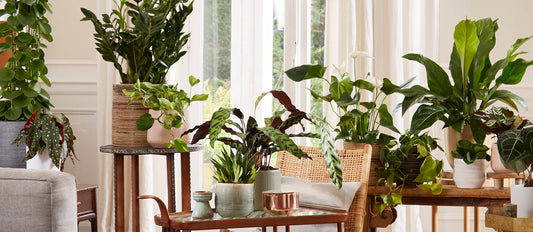Greenery can go anywhere, even in dark rooms or small spaces. It would be difficult to place a large Strelitzia in these spaces. However, there are many fun and creative ways to add greenery here too. Hanging plants can play a key role in adding colour to smaller spaces. We'll show you how.
1. Hanging lianas, but not for swinging on
Hanging plants such as the string-of-pearls plant or the lipstick plant are known for their long stems which can grow down to the ground. So we can let these lianas dangle for a true jungle effect. You probably have plenty of space to hang plants in the height. Allow the stems to grow where they won't get in your way. For example, give your staircase a splash of green colour. Hang the plant on the top floor and let the stems and leaves dangle freely in the stairwell. It will produce an amusing sight every time you walk upstairs. Or create a true jungle cabinet! Place one or more high flower pots on top of a somewhat lower cabinet and let the stems of the hanging plants grow down the side of the cabinet. This way you will have a mini urban jungle in no time.
Tip: Plants that are positioned high up get less sunlight and dry out more quickly. So choose a plant that grows well in the shade and does not need watering too often. You can always find this on the plant label. Also, make sure that you can reach the pot for watering. Otherwise, you’ll have to climb.
2. Wall decoration
The green wall is becoming an increasingly popular concept. Such a wall with plants is, of course, ideal in a small space. There are 2 ways of creating a green wall: grow the plants directly on the wall or use a plant rack. In order to furnish your wall or perhaps even ceiling with greenery, you can use climbing plants. These plants grow fairly quickly and will seek out space by themselves. This will add a nice splash of colour to your wall. A suitable plant for this is the Epipremnum. This climbing plant can reach great heights due to its aerial roots. However, the plant does need a little help climbing when indoors. The aerial roots, unlike those of a Hedera, cannot adhere to a smooth wall. The advantage is that the roots cannot damage the wall. You can attach the stems of the plant by means of cable clips or adhesive clips. Create your own patterns on the wall and ceiling for your own living wall.
Would you rather have several plants on the wall? Then use a plant rack. You can affix this iron rack to the wall with appropriate fixings. A variety of pots can be hung in the rack to create a beautiful indoor garden. Ensure that the weight of the plant and pot is taken into account. We recommend that you hang small indoor plants in the rack, such as nice succulents or bouncy ferns.
3. Table clamp with plants
This is a trend you really shouldn't miss: table clamps! You attach this rack to the sides of the table, so that you can hang all kinds of pretty things above the table. And what's more pleasing than plants above your table? Decorate the rack with lovely hanging pots and lanterns in between. That will allow your plants to shine. In the pots, we recommend small cacti, tillandsia and small hanging plants such as the Chinese lantern. A wonderful, atmospheric way to dine!
4. Vertical plant hanger
Do you have an empty corner in your room or a gap on one of the walls? Even areas smaller than half a square metre can easily accommodate several plants. Once again, the height of the room will be used. Not with hanging plants this time, but with a homemade plant hanger. What do you need? A few planks, 4 long and sturdy ropes and a hanging hook. The ropes should be able to reach from the ceiling to the ground and the planks should be a little wider than a flower pot. You can easily make your own plant hanger by following these steps:
- Step 1: Drill holes in the planks so that the ropes can pass through them.
- Step 2: Tie the ropes together at the top to form a loop. This will go over the hook once the hanger is assembled.
- Step 3: Slide the ropes through the planks and tie a knot in the rope after each plank before continuing. Ensure that the planks hang level to prevent the flowerpots from sliding around.
- Step 4: Choose how many planks to attach. Take into account the height of your plant.
- Step 5: You can choose to make the plant hanger more sturdy by securing it to the ground or holding it in place with weights.
- Step 6: The most important thing, of course, is choosing the plants! Go for plants with as much colour as possible: flowering indoor plants. For example, let the flamingo flower (Anthurium) take flight. A herb hanger with mint, basil and chives could also be nice.
There are enough possibilities to add some green to all the rooms in your house. Do you want to get started with plants? Take a look at our wide range of houseplants.




